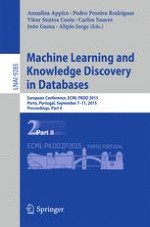The three volume set LNAI 9284, 9285, and 9286 constitutes the refereed proceedings of the European Conference on Machine Learning and Knowledge Discovery in Databases, ECML PKDD 2015, held in Porto, Portugal, in September 2015. The 131 papers presented in these proceedings were carefully reviewed and selected from a total of 483 submissions. These include 89 research papers, 11 industrial papers, 14 nectar papers, 17 demo papers. They were organized in topical sections named: classification, regression and supervised learning; clustering and unsupervised learning; data preprocessing; data streams and online learning; deep learning; distance and metric learning; large scale learning and big data; matrix and tensor analysis; pattern and sequence mining; preference learning and label ranking; probabilistic, statistical, and graphical approaches; rich data; and social and graphs. Part III is structured in industrial track, nectar track, and demo track.
